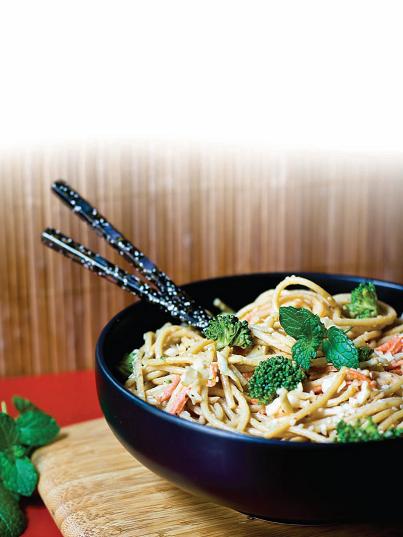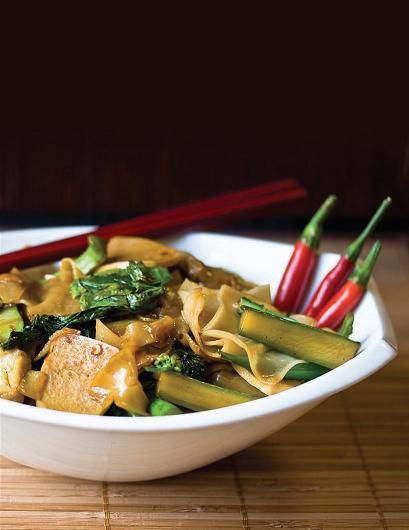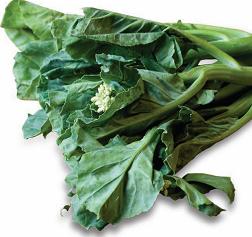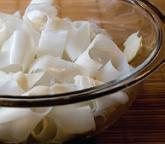Vegan Yum Yum (35 page)

¼ teaspoon ginger powder
(optional)
1 to 2 teaspoons of peanut or canola oil
2 cups kale, shredded
1½ cups seitan, cut into strips
1 large carrot, shredded
2 handfuls cashews, crushed
(or substitute peanuts; save some for garnish)
Lime slice, for garnish
Nearly Raw Tahini Noodles
I
use tahini in this recipe, which is a paste made from hulled sesame seeds that is commonly used in the Middle East. The seeds can be raw or roasted, and the flavor will vary depending on which one you choose. My favorite tahini is Arrowhead Mills Organic Sesame Tahini, which is unroasted. It's not too bitter, and it stays smooth and easy to use even after refrigeration. Roasted tahini will also work great in this recipe, but the flavor will be noticeably different.

Sesame paste, on the other hand, is an Asian ingredient that turns the whole sesame seed, including the hulls, into a paste. It's stronger than tahini, so you usually need much less in your recipes, and using too much can cause the dish to be more bitter than you expected. While you can find tahini at any supermarket (look near the peanut butter), Asian sesame paste still seems relegated to specialty markets.
This dish is largely raw, which cuts down on a lot of the work and prevents your summer kitchen from becoming a sauna. I've found that if you cut your veggies small enough and have a great sauce, you'll be surprised at what you can serve raw. If you like, you can lightly steam the broccoli, but it really is tasty simply cut into tiny florets. If you follow a raw food diet, feel free to substitute the cooked wheat noodles with cucumber or zucchini noodles, or whatever raw noodles make you the happiest. Pretty much anything will work as the base of this dish. The other benefit of this dish is that it keeps really well, so I like to make a big batch for lunches, snacks, or meals to go.
Note: This will easily keep for a couple of days. If you're a big fan of sauce, you may want to double the recipe. This recipe makes just enough to coat the noodles. Extra sauce will really come in handy after the completed dish has been refrigerated for a bit; I find noodles really soak up sauces, so it can be nice to have some extra on hand.
If you've tried tahini and disliked it, give it another chance. It's kind of vile on its own, so balancing flavors is very important with this ingredient. If you want a little tahini flavor but can't quite use the full ¼ cup, consider adding some peanut butter in lieu of the tahini. Personally, I find this a really refreshing change from the typical peanut sauces, and since it's so easy to make, why not give it a shot?
Nearly Raw Tahini Noodles
Makes 4 to 6 servings
step 1
Cook the pasta and rinse under cold water. Drain and set aside, coating lightly with oil if desired to prevent the noodles from sticking. These can be made well in advance.
step 2
Cut the cabbage into quarters, using a large chef's knife to remove the core from one of the quarters. Discard the core and wrap up the other three quarters for later use. If you have a food processor, use it to shred the cabbage and carrots. Use the shredder blade that has many holes for the carrots, and the blade that has one single slit for the cabbage. A box grater will work just fine for the carrots and a knife for the cabbage if a food processor is not available.
step 3
Chop the broccoli into small florets, creating pieces no bigger than small grapes.
step 4
Toss all the veggies together and add the pasta.
step 5
To make the tahini sauce, mix together the tahini, tamari, water, agave nectar, vinegar, chili sauce, mustard, salt, and black pepper, tasting to adjust if needed.
step 6
When you're ready to serve, add the sauce to the noodles and veggies and toss with your hands, coating everything evenly. Add chopped mint at the last moment, if using. Garnish with more mint and sesame seeds and serve.
Ingredients
½ pound uncooked whole wheat spaghetti
¼ of a green cabbage head, shredded
2 carrots, peeled and shredded
1 stalk broccoli, florets only, cut very small
1 handful fresh mint, chopped
(optional)
or use cilantro or basil instead
Sesame seeds, for garnish
Mint, for garnish
Tahini Sauce:
¼ cup tahini
2 tablespoons low-sodium tamari, Nama Shoyu, or regular soy sauce
3 tablespoons water
1 tablespoon sugar or raw agave nectar
1 tablespoon rice vinegar
1 teaspoon chili sauce or 1 chopped fresh chili
1 teaspoon Dijon or stone-ground mustard
1 pinch salt, if needed
Fresh black pepper, to taste
Pad See Ew
I
was so enamored with pad Thai that I never considered ordering anything else when I went out for Thai food. Pad see ew is salty and slightly sweet, unlike its sweet and tangy cousin pad Thai. This is a quick-cooking dish, as it should be, since it's common “street food” in Thailand. You really want to keep the Chinese broccoli crisp, the fresh noodles cook almost instantly, and the gluten just needs to be warmed and coated with sauce. I went from pulling ingredients out of the fridge to eating in 25 minutes. Unfortunately, this dish requires some “specialty” ingredients, but I think (read: hope) the substitutions will be okay.

Pad See Ew
Makes 4 servings
Specialty Ingredients Needed (and Suggested Substitutions):
Chinese broccoli:
This is a leafy cross between broccoli and cabbage, and it's awesome. Its stalks look like thick asparagus (or thin broccoli), and its leaves are dark and large. I found bags of it at my Asian grocer, but if you can't find it, I suggest using rapini, broccolini, regular broccoli plus kale and collards, bok choy, or chard.
Chow fun:
Chow fun are wide, flat sheet rice noodles that you cut to size yourself. Mine came in long rolls, so it was easy to remove some from the package, slice them, and toss them in. I've read that dry rice noodles become mushy too easily in this dish; fresh chow fun are strongly recommended. If you're going to try dry noodles, I suggest finding the widest rice noodle you can. Slightly undercook it and then shock it in cold water to stop the cooking. Drain very well, as you don't want to add water to the recipe.
Dark soy sauce:
It may seem weird to call for two different types of soy sauce in the same recipe, but it really does make a nice flavor for the dish. If you can't find dark soy sauce (that's literally what it's called), use tamari or your regular soy sauce. A combination of Nama Shoyu (for the light) and tamari (for the dark) would work just fine.

step 1
Cut the noodles into -inch thick pieces (I used about 8 noodle rolls). If curled, unroll them a bit. Don't worry if they break. Here is a shot of what my noodles looked like after I cut them:
-inch thick pieces (I used about 8 noodle rolls). If curled, unroll them a bit. Don't worry if they break. Here is a shot of what my noodles looked like after I cut them:
step 2
Heat the oil in a large pan or wok. Depending on the size of your cookware, you might need to make two separate batches to serve four, but it cooks quickly so don't worry too much about it. Add the garlic and sauté over medium-low heat until just starting to brown.

step 3
Add pepper flakes and ginger (if using) and cook for 1 minute more.
step 4
Add broccoli and stir-fry until tender crisp, just a few minutes.
step 5
Add gluten, soy sauce, sugar, and cooked noodles. Stir well, cooking for a minute or two. Toss so that the sauce has coated everything well, though it will be light. It's okay if your noodles break up a bit! Cook a few minutes more until the greens are wilted and the stems are no longer raw, but they should still be very crispy. If you cook it too long, your noodles will start to get mushy. Serve immediately with more sugar, soy sauce, and/or chili sauce available at the table. People generally season their Pad see ew outside of the wok to their own tastes.
Ingredients
 package chow fun (about 1.8 lbs; see “Specialty Ingredients”)
package chow fun (about 1.8 lbs; see “Specialty Ingredients”)